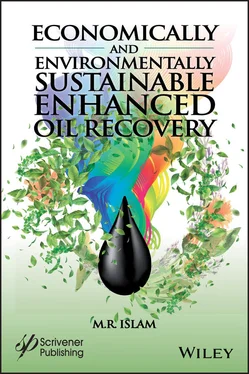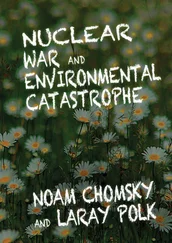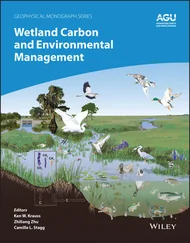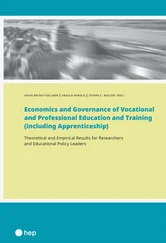6 Chapter 6Figure 6.1 US oil production in million barrels/day (data from EIA, 2019).Figure 6.2 Global production and consumption (From EIA, 2019). Liquids fuels...Figure 6.3 Number of EOR projects during 1971-2006 (from Alvarado and Manriq...Figure 6.4 EOR projects in post Cold war era (from IEA, 2018).Figure 6.5 Global EOR projects (From IEA, 2018).Figure 6.6 Global oil production due to EOR activities.Figure 6.7 Solar EOR of Oman.Figure 6.8 (a) status quo; (b) Sustainable (from IEA, 2018b).Figure 6.9 Various available EOR methods, with their typical percentage incr...Figure 6.10 Various EOR techniques with subcategories.Figure 6.11 Reserve-to-production ratios (R/P) for various regions and over ...Figure 6.12 US oil production under different categories in 2000 (Data from ...Figure 6.13 Incremental recovery owing to EOR (data from IEA, 2017).Figure 6.14 US reserve/production (R/P) ratio variation over the years (Data...Figure 6.15 US reserve/production (R/P) ratio variation over the years (Data...Figure 6.16 Crude oil production continues to rise overall (Enerdata, 2018)....Figure 6.17 History of US crude oil and lease condensate proved reserve (Dat...Figure 6.18 USA reserve variation in recent history (From EIA, 2018).Figure 6.19 US Gas production history (EIA, 2018).Figure 6.20 US gas reserve-production history (Data from EIA, 2018).Figure 6.21 Sulfur content of the U.S.A. crude over the last few decades (Fr...Figure 6.22 Declining API gravity of USA crude oil (from EIA, 2019a).Figure 6.23 Decline in high-sulfur fuel consumption (From EIA, 2019).Figure 6.24 Worldwide crude oil quality (From Islam, 2014).Figure 6.25 Projection of tight oil under different conditions (from EIA, 20...Figure 6.26 Technically recoverable oil and gas reserve in USA (From Islam e ...Figure 6.27 US projections of utilization of various energy sources for elec...Figure 6.28 Last few decades have seen an increase in efficiency of refineri...Figure 6.29 US refining capacity (from EIA, 2018a).Figure 6.30 R/P Ratio vs. proven reserve for top oil producing countries.Figure 6.31 Declared reserve for various countries (Updated from Islam et al Figure 6.32 Changes in global reserve shares (From BP, 2018).Figure 6.33 Distribution of proved reserve for various regions (From BP, 201...Figure 6.34 Distribution of proved reserve for various regions (From BP, 201...Figure 6.35 Global R/P ratios during 1980-2017 (data from BP reports).Figure 6.36 Recovery rates decline around the world (From Speight and Islam,...Figure 6.37 Future prospect of unconventional gas (EIA, 2019).Figure 6.38 Future prospect of unconventional oil and gas in various countri...Figure 6.39 Global unconventional shale oil and gas (dark spots: with resour...Figure 6.40 Three is a lot more oil and gas reserve than the ‘proven’ reserv...Figure 6.41 Major investment in oil sands in Canada (From Islam et al ., 2018...Figure 6.42 Past emissions and projected emissions of Alberta, Canada.Figure 6.43 Oil production rate history for top oil producers (from EIA, 201...Figure 6.44 Key to sustainability in energy management.Figure 6.45 Distribution of World’s proven reserve (from Alboudwarej et al .,...Figure 6.46 Viscosity change invoked by temperature (From Alboudwarej et al ....Figure 6.47 Much more oil can be recovered with double dividend of environme...Figure 6.48 The need for EOR is evident in production and oil quality declin...Figure 6.49 For the same investment, return is much different depending on t...Figure 6.50 Drilling activities in the United States for various years (EIA,...Figure 6.51 Uncompleted drilling activities in USA (from EIA, 2019).Figure 6.52 Locations of uncompleted drilled wells (from EIA, 2019).
7 Chapter 7Figure 7.1 Projected recovery with thermal and CO 2injection schemes.Figure 7.2 Evolution of oil production (1000 bbl/day) of EOR projects in the...Figure 7.3 Evolution of CO 2projects and oil prices in the United States. Fr...Figure 7.4 CO 2-EOR recovery in the United States throughout history (from Is...Figure 7.5 Update information and future prediction of CO 2-EOR (data from EI...Figure 7.6 Alberta government strategy.Figure 7.7 Natural gas production with CO 2injection schemes. From Khan et a ...Figure 7.8 Alberta’s plan to implement comprehensive Carbon management schem...Figure 7.9 CO 2sequestration demonstration projects around the world.Figure 7.10 Canada’s greenhouse gas emission status (data from Canada Climat...Picture 7.1 Petra Nova Project.Figure 7.11 Carbon intensity of the Petro Nova project (EIA, 2018).Figure 7.12 Rendering CO 2zero-waste.Figure 7.13 Bitumen production, past and future prediction (from AER, 2018)....Figure 7.14 Annual crude oil production from Oil Sands by Technology (Holly Figure 7.15 Schematic of the SAGD process.Figure 7.16 Average permeability for various formation and their depth. From...Figure 7.17 Schematic of bitumen extraction and processing.Figure 7.18 Phase diagram for various process reactions (from Bose, 2015).Figure 7.19 Removal of sulphur.Figure 7.20 As environmental regulations have become more stringent, natural...Figure 7.21 Change in viscosity for change in temperature.Figure 7.22 Surface tension changes with temperature with different slopes f...Figure 7.23 Residual oil saturation as a function of temperature. Modified f...Figure 7.24 Residual oil reduction with temperature for pre- and poststeamfl...Figure 7.25 Comparison between LASER and cyclic steam injection (modified fr...Figure 7.26 First pilot results of LASER (AER, 2017).Figure 7.27 LASER in second cycle (AER, 2017).Figure 7.28 Greenhouse gas dividend related to Cold Lake project (Bayestehpa...Figure 7.29 Various zones with principal reactions.Figure 7.30 Trends in ISC and HPAI. From Alvarado and Manrique (2010).Figure 7.31 Schematic of THAI process (from Greaves and Xia, 2004).Figure 7.32 Upgrading with THAI and CAPRI (from Greaves and Xia, 2004).Figure 7.33 True boiling points of THAI and upgraded oils (from Hart and Woo...Figure 7.34 Classes of catalytic upgrading reaction pathways for large aliph...Figure 7.35 The process of surfactant manufacturing.Figure 7.36 Increasing temperature leads to decreasing stabilityFigure 7.37 Basic chemical structure of KYPAM. (R1, R2, and R3=H or C1‐C12 a...Figure 7.38 Turning synthetic to natural will accomplish both environmental ...Figure 7.39 A trehalose ester (from Holmberg, 2001).Figure 7.40 Dynamic IFT for two types of surfactants.Figure 7.41 pH and soap concentration profiles along fractional distance at ...Figure 7.42 Pressure maintenance program involves artificially boosting pres...Figure 7.43 Various components of CSEGR.Figure 7.44 Density of CO 2and CH4 as a function of pressure for various tem...Figure 7.45 Viscosity of CO 2and CH4 as a function of pressure for various t...Figure 7.46 Crosssection of the CSEGR site (from Islam, 2014).Figure 7.47 Distribution of EOR methods in various lithologies (1500 EOR pro...Figure 7.48 Potential benefits of coupling CO 2EOR with storage. CCS, carbon...Figure 7.49 Examples of EOR in offshore fields: (a) North Sea EOR Projects (...Figure 7.50a Field pressure of SWAG with low injection rate (from Nangacovie...Figure 7.50b Comparison between WAG and SWAG in North Sea formation. From Na...Figure 7.51 Recovery with various flood scheme (from Kumar and Mondal, 2017)...Figure 7.52 Simplified schematic of a refinery.Figure 7.53 Primary reaction in catalytic reforming.Figure 7.54 The temperature dependence of various components of crude oil (f...
8 Chapter 8Figure 8.1 Crude oil formation pathway (After Chhetri and Islam, 2008).Figure 8.2 General activities in oil refining (Chhetri and Islam, 2007b).Figure 8.3 Pathway of oil refining process (After Chhetri et al., 2007).Figure 8.4 Natural gas “well to wheel” pathway.Figure 8.5 Natural gas processing methods (Redrawn from Chhetri and Islam, 2...Figure 8.6 Ethylene glycol oxidation pathway in alkaline solution (After Mat...Figure 8.7 Schematic showing the position of current technological practices...Figure 8.8 Different phases of petroleum operations which are seismic, drill...Figure 8.9 Economic models have to retooled to make price proportional to re...Figure 8.10 Summary of the historical development of the major industrial ca...Figure 8.11 Natural chemicals can turn an sustainable process into a sustain...Figure 8.12 Schematic of wave length and energy level of photon (From Islam Figure 8.13 Breakdown of the no-flaring method (Bjorndalen et al., 2005).Figure 8.14 Supply chain of petroleum operations (Khan and Islam, 2007).Figure 8.15 Typical steam power plant.Figure 8.16 Collector efficiency at different direct normal irradiance (DNI)...Figure 8.17 The thermal loss of the collector with respect to fluid temperat...Figure 8.18 Parabolic Trough.Figure 8.19 Cross section of collector assembly (Redrawn from Odeh et al., 1...Figure 8.20 Constructed parabolic trough.Figure 8.21 Experimental solar trough (from Khan and Islam, 2016).Figure 8.22 Water vapor absorption by Nova Scotia clay (Chhetri and Islam, 2...Figure 8.23 Decrease of pH with time due to sulfur absorption in de-ionized ...Figure 8.24 Schematic of sawdust fuelled electricity generator.Figure 8.25 The schematic of the separation unit (from Chaalal and Islam, 20...Figure 8.26 Unconventional reserve growth can be given a boost with scientif...Figure 8.27 Profitability grows continuously with time when zero-waste oil r...
Читать дальше












